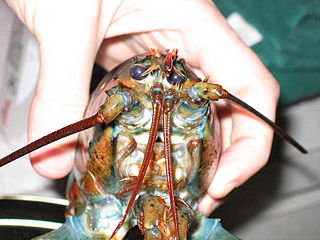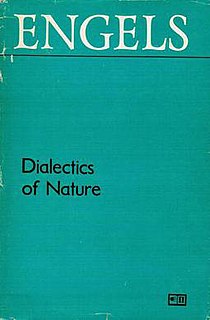
A chordate is an animal of the phylum Chordata. During some period of their life cycle, chordates possess a notochord, a dorsal nerve cord, pharyngeal slits, and a post-anal tail: these four anatomical features define this phylum. Chordates are also bilaterally symmetric, and have a coelom, metameric segmentation, and circulatory system.

In taxonomy, a group is paraphyletic if it consists of the group's last common ancestor and all descendants of that ancestor excluding a few—typically only one or two—monophyletic subgroups. The group is said to be paraphyletic with respect to the excluded subgroups. The arrangement of the members of a paraphyletic group is called a paraphyly. The term is commonly used in phylogenetics and in linguistics.

Reptiles are tetrapod animals in the class Reptilia, comprising today's turtles, crocodilians, snakes, amphisbaenians, lizards, tuatara, and their extinct relatives. The study of these traditional reptile orders, historically combined with that of modern amphibians, is called herpetology.

Colin Hiram Tudge is a British science writer and broadcaster. A biologist by training, he is the author of numerous works on food, agriculture, genetics, and species diversity.

Sarcopterygii —sometimes considered synonymous with Crossopterygii —is a clade of the bony fish whose members are known as lobe-finned fish. The group Tetrapoda, a superclass including amphibians, reptiles, and mammals, evolved from certain sarcopterygians; under a cladistic view, tetrapods are themselves considered a group within Sarcopterygii.

A polyphyletic group is a set of organisms, or other evolving elements, that have been grouped together but do not share an immediate common ancestor. The term is often applied to groups that share characteristics that appear to be similar but have not been inherited from common ancestors; these characteristics are known as homoplasies, and the development and phenomenon of homoplasies is known as convergent evolution. The arrangement of the members of a polyphyletic group is called a polyphyly.

A craniate is a member of the Craniata, a proposed clade of chordate animals with a skull of hard bone or cartilage. Living representatives are the Myxini (hagfishes), Hyperoartia, and the much more numerous Gnathostomata. Formerly distinct from vertebrates by excluding hagfish, molecular and anatomical research in the 21st century has led to the reinclusion of hagfish, making living craniates synonymous with living vertebrates.
In animal anatomy, a cloacakloh-AY-kə is the posterior orifice that serves as the only opening for the digestive, reproductive, and urinary tracts of many vertebrate animals, opening at the vent. All amphibians, reptiles, birds, and a few mammals have this orifice, from which they excrete both urine and feces; this is in contrast to most placental mammals, which have two or three separate orifices for evacuation. Excretory openings with analogous purpose in some invertebrates are also sometimes referred to as cloacae. Mating by cloaca is known as cloacal copulation, commonly referred to as cloacal kiss.

The lancelets, also known as amphioxi, consist of some 30–35 species of "fish-like" benthic filter feeding chordates in the order Amphioxiformes. They are the modern representatives of the subphylum Cephalochordata. Lancelets closely resemble, and are believed to be related to, 530-million-year-old Pikaia, fossils of which are known from the Burgess Shale. Zoologists are interested in them because they provide evolutionary insight into the origins of vertebrates. Lancelets contain many organs and organ systems that are closely related to those of modern fish, but in more primitive form. Therefore, they provide a number of examples of possible evolutionary exaptation. For example, the gill-slits of lancelets are used for feeding only, and not for respiration. The circulatory system carries food throughout their body, but does not have red blood cells or hemoglobin for transporting oxygen. Lancelet genomes hold clues about the early evolution of vertebrates: by comparing genes from lancelets with the same genes in vertebrates, changes in gene expression, function and number as vertebrates evolved can be discovered. The genome of a few species in the genus Branchiostoma have been sequenced: B. floridae,B. belcheri, B. lanceolatum

Placodermi is a class of armoured prehistoric fish, known from fossils, which lived from the Silurian to the end of the Devonian period. Their head and thorax were covered by articulated armoured plates and the rest of the body was scaled or naked, depending on the species. Placoderms were among the first jawed fish; their jaws likely evolved from the first of their gill arches. Placoderms are paraphyletic, and consist of several distinct outgroups or sister taxa to all living jawed vertebrates, which originated among their ranks. This is illustrated by a 419-million-year-old fossil, Entelognathus, from China, which is the only known placoderm with a type of bony jaw like that found in modern bony fishes. This includes a dentary bone, which is found in humans and other tetrapods. The jaws in other placoderms were simplified and consisted of a single bone. Placoderms were also the first fish to develop pelvic fins, the precursor to hindlimbs in tetrapods, as well as true teeth. Paraphyletic groupings are problematic, as one can not talk precisely about their phylogenic relationships, their characteristic traits and literal extinction. 380-million-year-old fossils of three other genera, Incisoscutum, Materpiscis and Austroptyctodus, represent the oldest known examples of live birth.

Vertebrate Palaeontology is a basic textbook on vertebrate paleontology by Michael J. Benton, published by Blackwell's. It has so far appeared in four editions, published in 1990, 1997, 2005, and 2014. It is designed for paleontology graduate courses in biology and geology as well as for the interested layman.

Parareptilia is a subclass or clade of reptiles which is variously defined as an extinct group of primitive anapsids, or a more cladistically correct alternative to Anapsida. Whether the term is valid depends on the phylogenetic position of turtles, whose relationships to other reptilian groups are still uncertain. The parareptiles lived from late Carboniferous till the end of the Permian, except from one group, the Procolophonoidea, which are the only parareptiles known to have survived the end-Permian extinction, and didn't disappear until the late Triassic.

Paleobiology is a growing and comparatively new discipline which combines the methods and findings of the life science biology with the methods and findings of the earth science paleontology. It is occasionally referred to as "geobiology".
Hans-Dieter Sues is a German-born American paleontologist who is Senior Scientist and Curator of Vertebrate Paleontology at the National Museum of Natural History of the Smithsonian Institution in Washington, DC.

Jon Linden Wynne-Tyson was an English author, publisher, Quaker, activist and pacifist, who founded Centaur Press in 1954. He ran Centaur Press from his home in Sussex and was a distinguished independent publisher. He authored books on animal rights and vegetarianism. At one time Wynne-Tyson held the title of "King of Redonda", a literary title referencing a small island.

Darwinius is a genus within the infraorder Adapiformes, a group of basal strepsirrhine primates from the middle Eocene epoch. Its only known species, Darwinius masillae, lived approximately 47 million years ago based on dating of the fossil site.

Phytodinosauria is a group of dinosaurs proposed in 1986, combining the Sauropodomorpha and Ornithischia as sister groups, conceptualized as a superorder of herbivorous dinosaurs excluding the carnivorous Theropoda. This hypothesis has been refuted by modern cladistic analysis, showing such a group to be polyphyletic. Modern studies either combine the Theropoda and Sauropodormorpha in the Saurischia or the Theropoda and Ornithischia in the Ornithoscelida.

The question of whether crustaceans experience pain is a matter of scientific debate. Pain is a complex mental state, with a distinct perceptual quality but also associated with suffering, which is an emotional state. Because of this complexity, the presence of pain in an animal, or another human for that matter, cannot be determined unambiguously using observational methods, but the conclusion that animals experience pain is often inferred on the basis of likely presence of phenomenal consciousness which is deduced from comparative brain physiology as well as physical and behavioural reactions.

Dialectics of Nature is an unfinished 1883 work by Friedrich Engels that applies Marxist ideas – particularly those of dialectical materialism – to science.

Pain in cephalopods is a contentious issue. Pain is a complex mental state, with a distinct perceptual quality but also associated with suffering, which is an emotional state. Because of this complexity, the presence of pain in non-human animals, or another human for that matter, cannot be determined unambiguously using observational methods, but the conclusion that animals experience pain is often inferred on the basis of likely presence of phenomenal consciousness which is deduced from comparative brain physiology as well as physical and behavioural reactions.


















